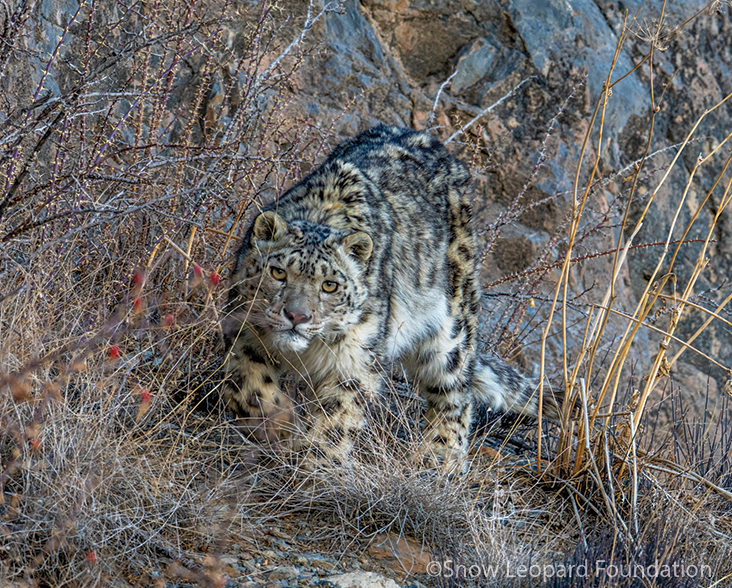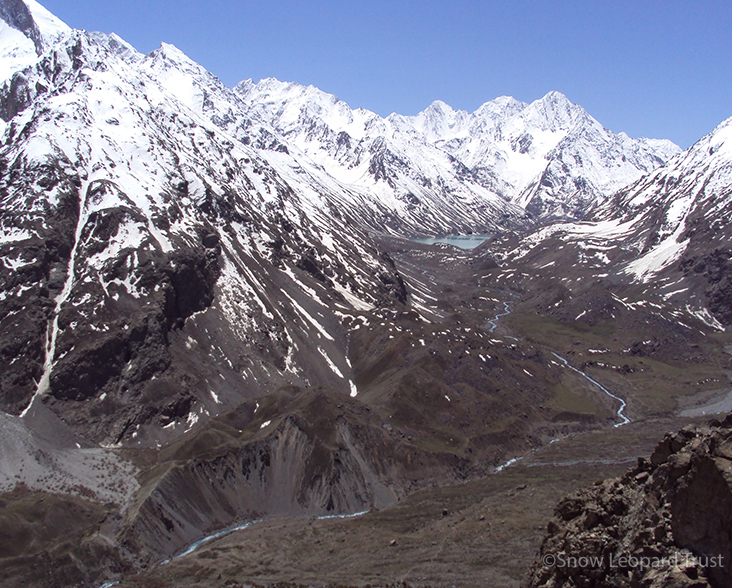Snow Leopard
Species Data
Class: Mammalia
Order: Carnivora
Family: Felidae
Scientific Name: Panthera uncia
IUCN Red List status: Vulnerable
Description
With adult females weighing 36-42 kg and the larger males reaching 52 kg, the Snow Leopard is one of the smaller of the world’s big cat species. The head-body length measures just 86-125 cm, but the tail, at 80-105 cm long, adds another 80% to the total length. Used to aid balance and for thermoregulation, Snow Leopards have the longest tail relative to head-body length of any big cat.
The Snow Leopard is well-adapted to living in cold, high-altitude mountainous environments. The background colour of their long, thick fur, which is longer in winter, varies from smokey-grey to greyish-buff with whitish on the underparts and is patterned with dark grey to black spots on the head and neck, and rosettes usually enclosing small spots on the body and tail. The coat colour and pattern, and their pale green or grey eyes, help them blend into their environment. Large, broad paws provide better weight distribution on snow, and fur on the underside improves grip and minimises heat loss. Small ears further minimise heat loss, and the short muzzle and doomed forehead allow for large nasal cavities that help them to breathe in thin mountainous air.
The pattern of spots and rosettes is unique to each animal, allowing Snow leopards to be recognised individually.
Behaviour
Although groups of 2–4 individuals can occur during the breeding season, adult Snow Leopards are generally solitary. Both sexes are territorial, with home range sizes varying geographically. Satellite telemetry studies in Mongolia show adult males have an average home range of 207 km2 and adult females of 124 km2. Both sexes communicate by leaving scent marks, such as spraying urine on the sheltered side of rocks, making scrapes along well-used travel routes, claw raking, and cheek/head rubbing.
This species is most active at dawn and dusk but will hunt any time during the day or night. These apex predators can kill prey up to three times their own weight. A large percentage of their diet consists of mountain-dwelling sheep and goats, especially Blue Sheep and Siberian Ibex, but smaller prey items such as marmots, pikas and voles make up a large part of their diet during the summer. They will also take domestic animals, including sheep, goats, cows, horses and dogs. During the winter, this species follows its preferred prey, which is forced to lower elevations by deep snow.
When hunting, Snow Leopards attack from a vantage point, pursuing prey across mountainsides and killing with a bite to the nape or throat. They often move carcasses to avoid attracting the attention of crows and vultures, and they will remain with the carcass for 3-5 days.
Snow Leopards mate between January and March with copulation over 3-6 days. Following a gestation period of 90–105 days, females give birth to usually 2–3 (rarely 1 or 4–5) cubs between April and June in a den such as a cave or rock crevice. The cubs put on 300-500 g a week, are weaned at about five months, and start following their mother at around 12 weeks. Females rearing 2-3 young require about three times the amount of food as a lone adult. Adult females and cubs stay together for about 1–2 years, and sexual maturity is reached at 2-3 years old. Life expectancy in the wild is up to 11 years.


Habitat
The Snow Leopard inhabits rugged and remote mountainous areas in central Asia, including the Himalayas in the south of their range, the Tibetan Plateau, and the mountains of southern Siberia in the north. Their range extends across twelve countries: Afghanistan, Bhutan, China, India, Kazakhstan, Kyrgyzstan, Mongolia, Nepal, Pakistan, Russia, Tajikistan, and Uzbekistan.
The habitats this species occurs in include high rocky areas, alpine meadows, alpine steppe scrub, and forest, between 500 m and 5,800 m, but usually above 3,000 m.
Threats and Conservation
Snow Leopards are secretive, difficult to detect, occur in low densities, and inhabit remote and rugged terrain, making estimating the global population difficult. Based on trail camera photos, the best guess is that 2710 to 3386 mature individuals remain in the wild.
Threats to Snow Leopards vary by country, but the main threats are habitat degradation from large-scale infrastructure, mining, and barriers such as roads or fencing; declines in prey species, retaliatory killing for depredation on livestock, and poaching for the illegal trade in furs, bones, and other body parts. Although this species is now protected across most of its range and has been on Appendix I of CITES since 1975, the global population is thought to be declining. Therefore, the Snow Leopard is classified as Vulnerable on the IUCN’s Red List.
To safeguard the Snow Leopard, WLT has partnered with the Snow Leopard Foundation to fund and establish the Bashqar Gol Biosphere Reserve in the Laspur Valley in north-west Pakistan.
